Coming out of idyllic Ubud, we realize that there is going to be quite a shift with our arrival in the Muslim and urban part of Indonesia. Having done, uncharacteristically, precious little research, Peta’s task is to find us places to stay that will both be “green” (in terms of surroundings, but also in terms of impact) and close enough to the city so that we can go in and out with ease. She does, as always, a splendid job and introduces us to the village of Tembi.
After an easy one hour flight from Denpasar, Bali to Yogyakarta, Java, we drop our bags off at a budget home-stay and set out to explore our surroundings. We walk past an attractive boutique hotel and go in to look around.
It’s empty. No travelers. The owner happens to walk by and offers us a deep discount on a gorgeous room. It’s such a great price, how can we refuse it for our first night in Yogyakarta?
 |
| The gardens of the hotel are very restful and serene with ponds, and lush green foliage |
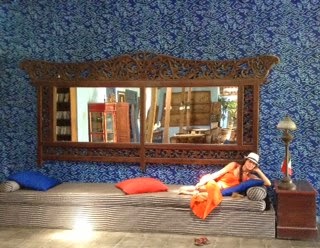 |
| Very impressive interior decoration with the trademark being the batik fabric wallpaper. Originally the hotel was a compound of houses ~ later converted into a hotel. |
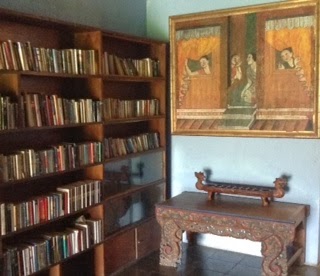 |
| A library and an extensive collection of interesting art and artisanal pieces. |
|

|
| It’s not often you see this sign on your bed table. We both quite enjoy the numerous prayers throughout the day, broadcoast to the whole village. |
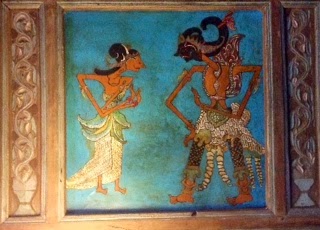 |
| Its fun to have an introduction to such a variety of Indonesian art both traditional and contemporary. |
This exquisite hotel is immersed in Javanese village life. In fact, the Australian owner, designer Warwick Pursue is a major philanthropist who started a national social enterprise that was intended to create “at least one job for each family in the village”. Over the course of 20 years, this business “Out of Asia” became the leading exporter of Javanese craft to major US retailers – Crate and Barrel, Pottery Barn, Target etc… In the process, this created 800 jobs. Taking his social enterprise concept one step further, actually 108 steps further, he created 108 micro-enterprises to date through a process of offering micro-financing loans. What started as natural outgrowths of the hotel for residents of Tembi, such as a laundry service, a restaurant, a transport business, grew exponentially.
Then, a major earthquake shook Yogyakarta and the entire village, as well as the hotel, was completely destroyed, in 2006. It has taken several years to help the village get back on its feet, rebuilding houses for villagers and generally getting past this devastating geological event.
We finally emerge from our beautiful art-filled cocoon and explore the surrounding Tembi Village…
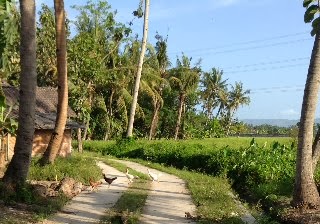 |
| There are chickens running freely everywhere !! Chickens and roosters are king here! |
As we stroll the dirt streets of the village, an arrow pointing to a Batik museum… We proceed and are rewarded with a beautiful collection of Indonesian puppets, swords, sculptures and batik.
Batik is part of Indonesia’s cultural heritage and can be traced back as a method developed inside the old kingdoms of Java.
Batik was acknowledged as world heritage by Unesco in 2009 and its popularity has reached new heights. With its uniqueness and richness in variety batik has inspired many Indonesian designers from fashion to interior decoration. Most businesses and schools make Friday “batik day” (when most people wear their batik clothing), and even a national holiday is dedicated to batik.
I (Peta) have always loved batik and was introduced to it at an early age by my mother, who inspired us as children to create batik paintings as well as T shirts with batik designs.
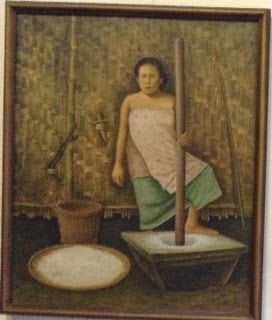 |
| Painting which depicts the grinding of the corn with a large wooden pole and carved container. |
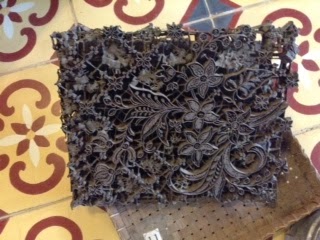 |
| This is a metal print used to create batik style designs which get printed repeatedly onto fabric. |
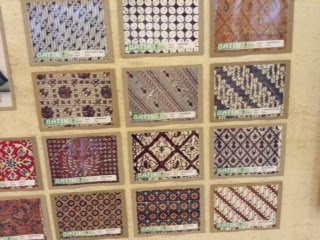 |
| These are some of the classic batik designs. They have different names and uses for the different designs. For example there are specific designs which are worn for important occasions only. |
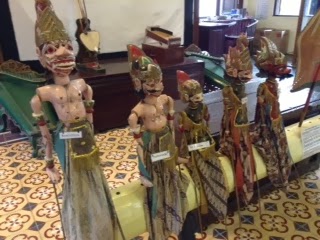 |
| Marionettes used for puppet shows with papier mache heads and upper bodies and batik fabric sarongs. |
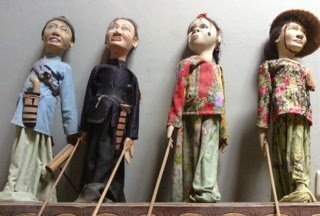 |
| This one is for my sister Dina, Puppeteer. |
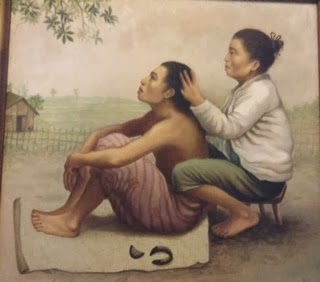 |
| Indonesian men traditionally had long hair. Still the case in Bali… |
Back on the road in the village, going through farmland
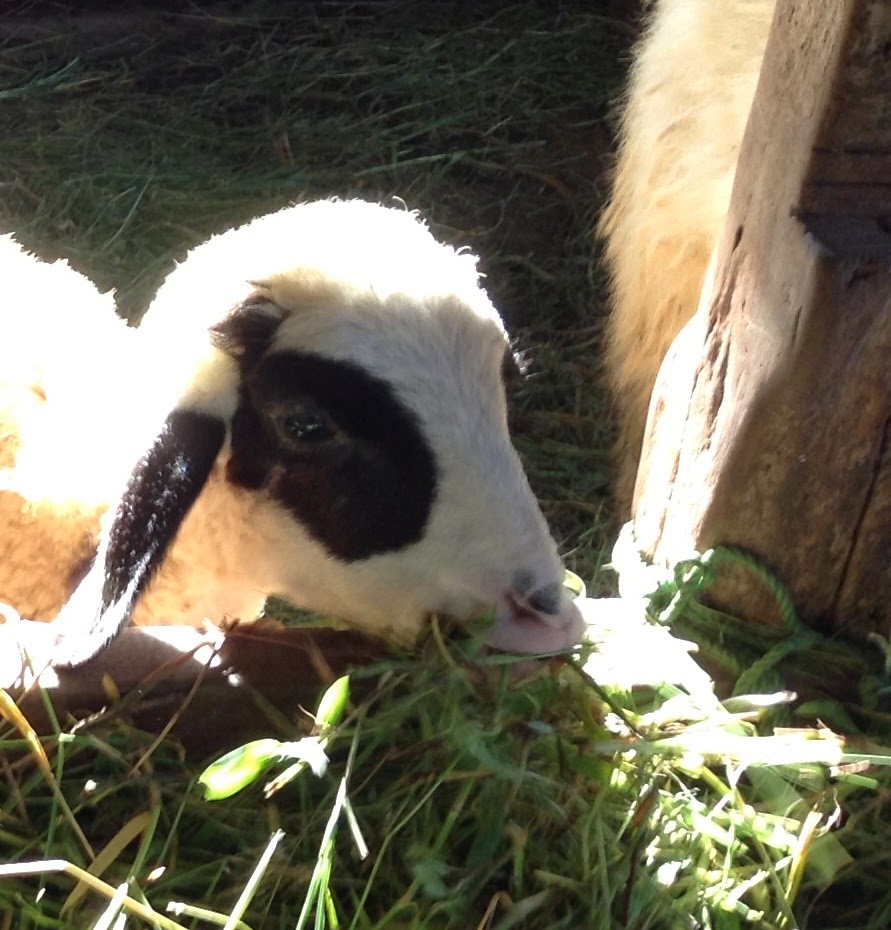 |
| A very cute baby goat with 2 ‘black eyes” and his momma. |
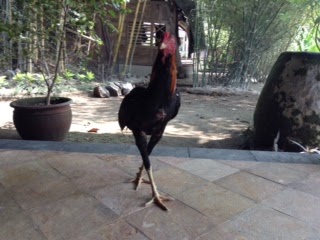 |
| And chickens EVERYWHERE…. |
 |
| Everywhere… |
And art also everywhere… 2 galleries, one with paintings, the other with batik paintings, in the village, supported by d’Omah hotel.
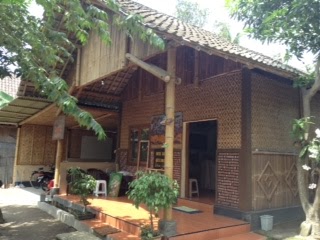 |
| Bamboo woven into mats is used to create the walls and ceiling of the gallery. |
Modern art, however, pales in comparison to the beauty of traditional art. A visit to the local batik artists… (“Leksa Ganesha”, which has a facebook fan page: leksa ganesha batik gallery).
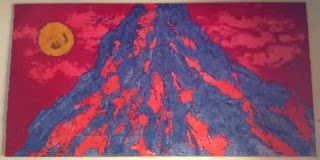 |
| Mount Merapi, as seen from the rice paddy. Yogyakarta is situated in one of the most volcanic zones on the planet. |
We continue our first day stroll… now hitting the main road… Political posters are everywhere. Indonesia is entering Election season (in April), when the very young democracy will go to the poll to vote its parliament in, and in July, a new presidential election. The stakes are high in this pluralist society where 240 million Muslims, Christians and Buddhist cohabit peacefully.
Talking of peaceful cohabitation – nothing like a shared meal to help bridge cultural distance… We are fortunate to strike a conversation with a lovely couple, who are waiting in line with us for their noodle soup at the little restaurant we stop at. The woman speaks some English and they invite us to sit with them for dinner. After the meal they insisted on paying for our food!
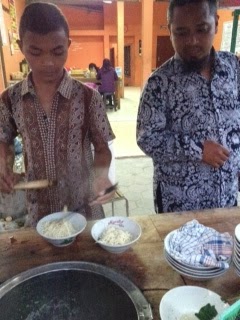 |
| The guy on the left is the vendor and the one on the right, a customer. Note they are both wearing batik shirts. |
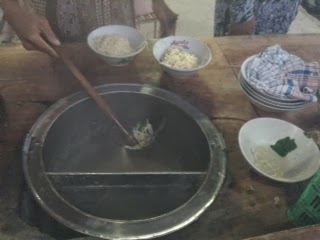 |
| The comforting smell of chicken soup is always good, in any country. |
Samur (on the left in the photo below) works as a hospital administrator in Yogyakarta. He quickly volunteers that even though he has a full day at work he also does some cooking for the family (rice is his assigned role, as well as washing dishes). Mayan (center) is a community reproductive health educator. In a muslim country, where pre-marital sex is a big no-no, you can imagine how challenging this job must be.
We discuss freely current health challenges ~ it turns out that HIV remains high on the list. After discussing issues of unclean needles shared by drug addicts, we quickly get to the reality that, numerically, there are a lot more people having unprotected sex, than people sharing needles. So it falls upon reproductive health professionals, like Mayan, to help bridge the gap between religious dictates and real life practices. Lack of education for the mothers, combined with social taboos about talking about sex, makes for a dangerous mix with teenage hormones. A big thank you to Samur and Mayan for such a warm welcome to Yogyakarta, and in the process for becoming our first Indonesian Muslim friends.
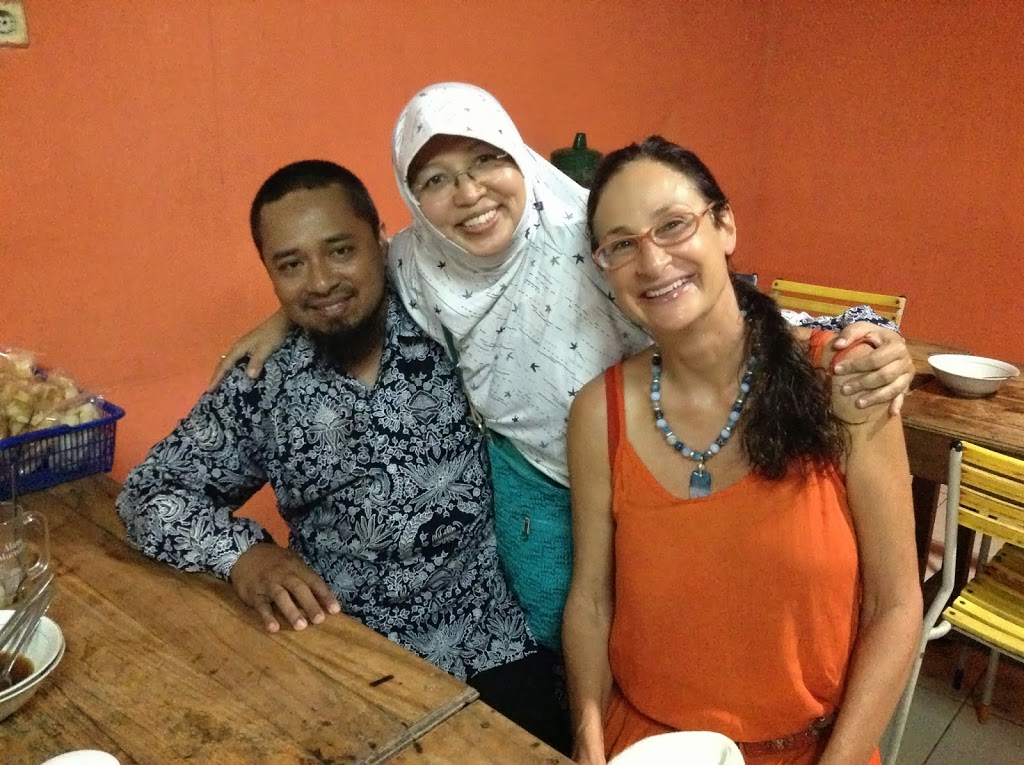 |
| Samur and Mayan. They have 2 daughters and a son. |
The next morning, still forming our “first impressions”, we opt to go visit the famed Prambanan Hindu Temple of Yogyakarta, which is the oldest such construction possibly in the world, pre-dating Egyptian pyramids. Destroyed in large part by the 2006 earthquake, it has been a painstaking archeologist work to piece the puzzle back together and reconstruct over a decade the grandeur of the towering monument…
A World Heritage compound, it is the largest Hindu compound in Southeast Asia, comprising the three main temples of Shiva, Vishnu and Brahma. Built in 900 A.D. It represents a masterpiece of the human creative genius and is an outstanding example of the Hindu and Buddhist religious heritage of the 10th century. What is interesting is that this Hindu monument reminds us that Indonesia used to be predominantly Hindu, before the global expansion of Islam. At the time, Islam became attractive because of such traits as its belief in the importance of education for all, including women.
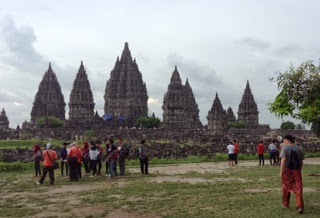 |
| The towers remind me of drip sand castles on the beach from a distance |
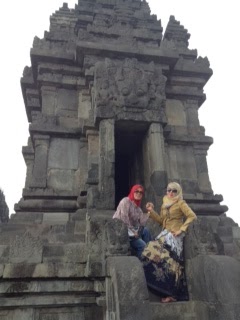 |
| Two fashionable women posing for a photo. |
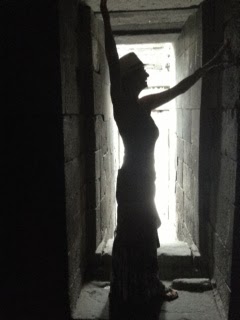 |
| Remindful of our Alien series of photos from My Son ancient Buddhist temple, Central Vietnam |
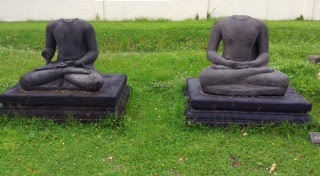 |
| Sadly, Western Museums and collectors of Asian Arts have financially rewarded the desecration of Buddhist stone sculptures. For over 2 centuries, treasure seekers have been beheading beautiful and historically important sculptures to bring back only the heads that are often displayed with pride in Western Museums. Here evidence of the carnage in a field of beheaded buddhist sculptures. |
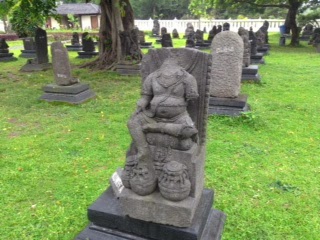 |
| More beheadings for the western world’s museum watching pleasure… |

























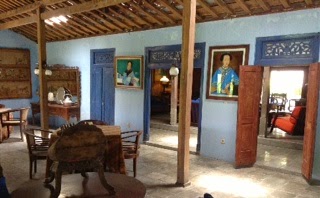
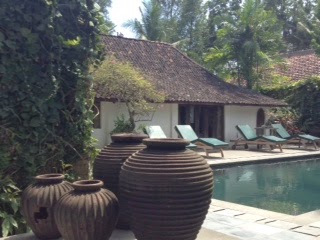
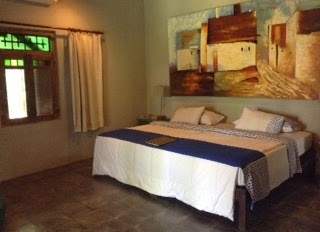

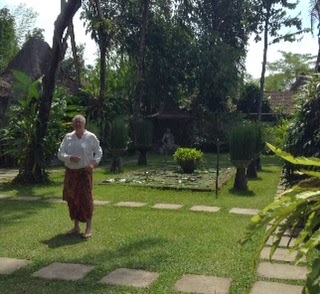
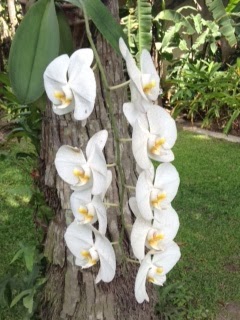
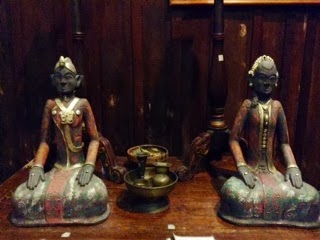
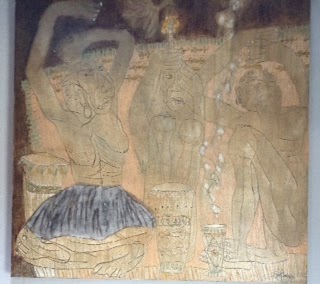
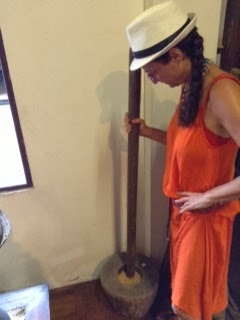
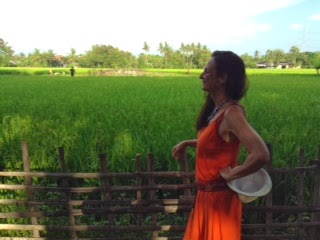
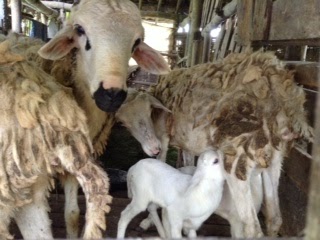
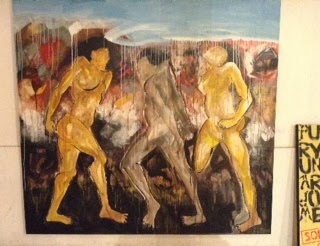
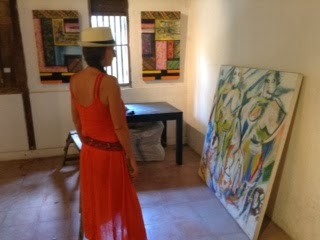

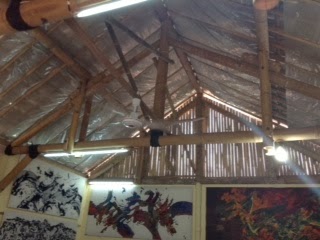
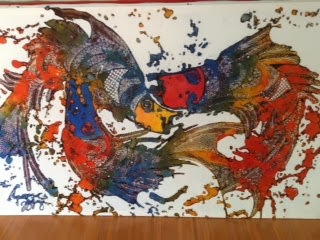

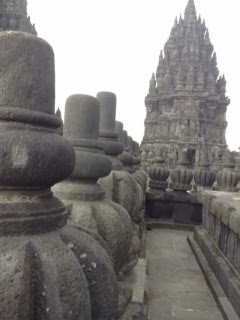
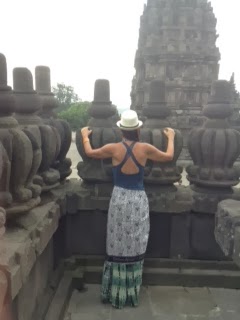

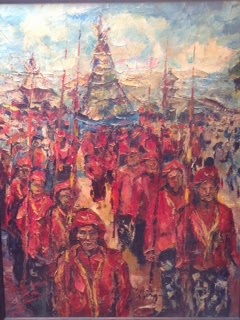
Hey there Peta!
Another nice installment – – – thank you so much. I saw in the hotel they left you a note in English about earplugs. Is English enough to get by on? Can you have meaningful conversations with the locals, or do you have to find interpreters to help the chat along? I suppose that they eat the chickens, no?
besos y abrazos,
Charles
Charles, we are planning on learning Indonesian. Apparently it is one of the easiest languages to learn! Yes, English is definitely enough to get by on.. That said, I am a great believer in non verbal communication and have found where ever we go, that one can communicate pretty effectively without language. Except of course, when you need to get or give specific directions, locations, then it can be a bit tricky. It leads to some pretty funny “pantomime” which is all part of the fun of interacting with people no matter the language. We never did use the earplugs. We loved the numerous calls to prayer, followed by the actual prayer, sometimes four or five mosques emitting prayers from loudspeakers, simultaneously. A cacophony of Arabic chanting (especially beautiful at sundown accompanied by a bright pink sky.) Chickens are eaten yes, but also for eggs and for cock fighting (sadly).
Enjoying all your blogging!
Mike
Great. It’s fun for us to see what people specifically react to. So don’t be shy and keep posting your comments…
Amazing P, We miss you so much!!!! We love the picture with the gigantic mirror and not to mention the picture of Ben in a Sarong, but so sad to see the headless sculptures…
Dina Shani Adam Tal
Hey Shani!!! So glad you are reading us… YEAH!!! We miss you too (can’t wait till you come and visit us somewhere in Asia).
(Ben): I’ve got 4 different sarongs now… they are SOOO comfortable. Not sure I can wear them outside of Bali… But who knows, maybe I can start a global Sarong wearing trend for men. I might try that next time I am in Chicago! (preferably not in November!)
Thank you for commenting on the headless sculptures. Yes, we found this to be very sobering. Something we had not realized when visiting Asian art museums before, but when you see rows and rows of decapitated sculptures, it becomes clear that national treasures should stay in their country of origin, or at least taken as a WHOLE, not by chopping out a piece because it’s more convenient. Imagine one day the Chinese coming to the Louvre in Paris and carving out a smaller piece of a 500 year old French tapestry or painting?!
Hi Tal, Adam and Dina… WHat do you guys think of the street art in Jogja?
Those chickens are so unlike anything here. Long legged and scrawny looking, I bet they are a primal version from which modern chickens were bred. In your recent post on chickens, I think in Ubud, you show some free range birds but also some protected in a feeding pen. Those were being raised for meat. I’m wondering if you’ll see operations like that in Java too. There’s just not much to eat on these Street birds. I think they’re keep for eggs, and insect control.
Beautiful! You always seem to find a peaceful environment. The headless statues are interesting.
Sophie! Nice to get your feedback. Yes the statues make you think about the Louvre type museums which proudly display their Asian art collection. We have never thought much about it before, but where do the heads come from and where are the bodies? Now we now…. A bit spooky actually to see rows of headless sculpted bodies.
Hey Ben, I’ll join you in the ‘new’ world wide trend of men wearing sarongs… I wear my Bali bought sarongs to the beach here and otherwise mostly indoors… Maybe I’ll really get more bold and wear mine out there to the store or some place… hmmm … Truly so comfortable though!!
Love reading about your time in Muslim Indonesia – hope to get there next time…
Awesome Temple!!!
Alright!! It’s a trend! Several million more to go and it will be a REAL trend.
Hi Peta and Ben,
I was recently in Yogyakarta where I met Tatang – I interviewed him about his work – you might be interested in reading it and sharing it with your audience.
http://www.withmanyroots.com/blog/using-batik-to-share-climate-messages
Many thanks,
Sophia
Hi Sophia, thanks for sharing this link with us. Very interesting interview, left us wanting to see more of Tatang’s work.
Ben
Thanks! I know, we left with 2 pieces but wish we had space for more!